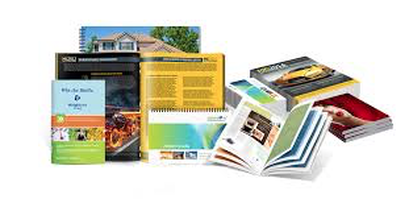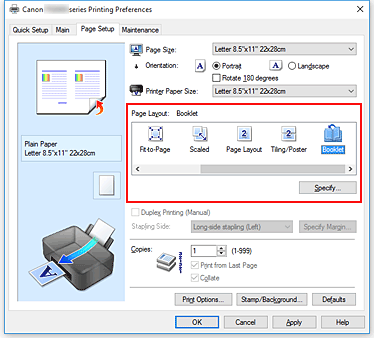How Booklet Printing Supports Omni-Channel Marketing Strategies
Wiki Article
The Vital Overview to Recognizing Pamphlet Printing Options and Techniques
The procedure of pamphlet printing includes several considerations that can greatly influence the final item. From choosing the ideal format and dimension to understanding the nuances of binding techniques, each choice plays an essential function. In addition, elements such as paper stock and printing techniques additional affect the efficiency of the brochure. As one browses these options, it becomes necessary to comprehend exactly how they adjoin and what that indicates for the overall result.Recognizing Brochure Formats and Dimensions
When thinking about pamphlet printing, comprehending the different layouts and dimensions available is necessary for achieving the desired discussion. Brochures can be created in countless layouts, consisting of saddle-stitched, spiral-bound, and perfect-bound, each offering distinctive benefits. Usual sizes vary from basic letter (8.5 x 11 inches) to smaller sized options like A5 (5.8 x 8.3 inches), enabling versatility based upon web content and target audience.Selecting the proper size can affect both the layout and reader interaction. Bigger sizes might suit visually driven content, while smaller sized styles may be extra straightforward and portable. Additionally, the number of web pages affects the choice of binding technique, as thicker brochures might call for tougher bindings. Inevitably, comprehending these facets permits a more customized method, making certain that the end product aligns with the intended message and visual, improving the total effectiveness of the interaction.Choosing the Right Paper Supply

Binding Techniques: Alternatives and Considerations
When it involves binding methods for booklets, a number of alternatives are readily available, each with distinct advantages. Saddle stitch binding uses a cost-efficient solution for thinner booklets, while ideal binding strategies give an even more polished look for thicker publications. Wire-O binding stands apart for its toughness and convenience of usage, making it ideal for records that need flexibility.Saddle Stitch Binding
Saddle stitch binding supplies a functional and affordable service for assembling brochures, making it a prominent choice among businesses and publishers. This binding technique includes folding sheets of paper in fifty percent and stapling them along the fold line, creating a well organized and cool appearance. Normally appropriate for booklets with a lower page count, saddle stitching is suitable for publications, brochures, and educational products. The simpleness of this technique enables quick production and is often preferred for short runs or marketing items. Nevertheless, it is necessary to keep in mind that saddle stitch binding might not be appropriate for thicker booklets, as the back might not stand up under boosted weight. Generally, it continues to be a reliable alternative for lots of printing projects.Perfect Binding Strategies
Perfect binding is a commonly used strategy that offers a specialist and refined coating to publications and pamphlets. This method entails gluing the pages with each other at the spinal column making use of a strong adhesive, enabling a tidy side and the capacity to hold a larger variety of pages compared to saddle sewing. Perfect binding is particularly appropriate for thicker booklets, such as directories and yearly reports, where a durable, level spinal column is desired. Additionally, it supplies the option for a published cover that can be designed to improve visual appeal. Factors to consider such as web page matter, paper weight, and the intended use of the brochure should be taken right into account, as they can affect longevity and total quality.Wire-O Binding Choices
Wire-O binding, recognized for its resilience and adaptability, uses a superb option for pamphlets that need easy web page transforming and a specialist look. This binding approach utilizes a series of metal loops that hold pages securely, allowing them to lie flat when open. It is particularly suitable for brochures, handbooks, and discussions because of its robust nature. Wire-O binding is available in various shades and sizes, fitting different page counts and thicknesses. In addition, it allows the addition of covers and tabs, boosting the pamphlet's general aesthetic. Factors to consider for Wire-O binding include the option of cable shade, the dimension of the loops, and the degree of customization wanted, all of which can profoundly affect the end product's appearance and performance.Digital vs. Offset Printing: Which Is Best for You?
When selecting a printing approach for brochures, comprehending the distinctions in between digital and counter printing is crucial. Digital printing uses modern technology to create high-quality prints quickly and affordably, making it perfect for brief runs or projects calling for fast turn-around times. It allows for modification, supplying the ability to publish on-demand with minimal waste.In comparison, offset printing is a conventional method that masters producing big amounts with regular top quality. It entails transferring ink from a plate to a rubber covering, then to the paper, which leads to dynamic shades and accurate information. However, balance out printing generally needs longer arrangement times and is much more cost-efficient for larger volumes.Ultimately, the selection between digital and balance out printing relies on task requirements, budget plan, and wanted quantity. For little, time-sensitive tasks, electronic could be the best choice, while balanced out may be more effective for bigger, high-grade productions.
Designing Your Booklet: Tips and Best Practices
When designing a pamphlet, mindful interest to design, font option, and shade usage can significantly enhance its effectiveness. A well-structured format overviews the reader's eye, while appropriate typefaces ensure readability and communicate the desired tone. In addition, efficient use shade can stimulate feelings and highlight key details, making the total design extra impactful.Picking the Right Design
Just how can one properly choose the best design for a brochure? Initially, it is essential to assess the brochure's function and target market. A clean, arranged design boosts readability and interaction. Utilizing a grid system can help in aligning aspects consistently, developing a professional look. Additionally, integrating aesthetic pecking order via varying Click This Link dimensions and placements of pictures and message can direct the viewers's eye and emphasize crucial information. It is likewise essential to leave adequate white room, which prevents congestion and enables better focus. Ultimately, testing different formats with mock-ups can supply understanding right into exactly how the style carries out in real-world circumstances, making certain that the end product fulfills both useful and aesthetic requirements.Choosing Appropriate Typefaces
A well-chosen font can significantly improve the general style of a brochure, matching the design and strengthening the content's message. The option of typefaces need to take into consideration readability, specifically for body message, as it assures the details comes to all viewers. Sans-serif typefaces are often preferred for digital layouts, while serif typefaces can offer a standard feel in printed materials. It's advisable to restrict font selections to two or three to maintain aesthetic comprehensibility. Furthermore, font style size plays an important duty; headings must be not frustrating however distinct, while body text need to fit for reading. When selecting typefaces, positioning with the brochure's theme and target market is necessary for efficient communication and visual appeal.Reliable Usage of Color
Shade functions as an effective tool in pamphlet layout, forming perceptions and guiding viewers emotions. It can evoke feelings of peace, count on, or enjoyment, depending upon the tones picked. Developers need to think about shade theory principles, guaranteeing that the picked palette aligns with the pamphlet's message and target market. For example, utilizing warm shades like red and orange can produce necessity, while cooler tones like blue and environment-friendly foster tranquility.Additionally, contrast plays an essential role; complementary colors can improve readability and aesthetic allure. Uniformity in shade use throughout web pages better reinforces brand name identification and communication. Inevitably, reliable shade execution not just records focus yet additionally enhances the pamphlet's objective, making it an essential aspect of effective layout.
Ending Up Touches: Coatings and Unique Effects
While many consider the content and layout of a pamphlet one of the most essential components, the ending up touches, such as finishes and unique impacts, play an important role in enhancing its total charm. Coatings can supply security and resilience, ensuring that the booklet holds up against deterioration. Matte surfaces offer an innovative, non-reflective surface area, while glossy coatings can make shades appear more vivid and captivating. Unique impacts, like embossing or foil marking, add a responsive dimension that can create a remarkable impression. These strategies can highlight certain areas, accentuating vital info or developing aesthetic passion. In addition, UV finish you could check here can offer a high-shine surface that elevates the total look.Together, these finishing touches not just enhance the brochure's aesthetic however also interact professionalism and trust and attention to detail, inevitably leaving a long lasting effect on the viewers.Cost Factors To Consider for Pamphlet Printing
Comprehending the numerous cost considerations for pamphlet printing is important for organizations and organizations intending to optimize their budget plans. Trick factors influencing expenses consist of the choice of paper, ink, and binding techniques. Better products, such as premium paper or specialized inks, usually raise the overall expense. Furthermore, the size and web page matter of the pamphlet play a substantial role; larger booklets require more resources and time to produce.Another crucial factor to consider is the printing strategy, whether electronic or countered, as each has its very own rates framework and viability for various amounts. Businesses should also factor in design costs, which can vary based on intricacy and using professional solutions. Inevitably, delivery and handling costs can include in the total amount, specifically for big orders. By examining these aspects, companies can make educated decisions that align with their economic capacities while accomplishing the preferred high quality in their printed materials.Regularly Asked Inquiries
What Are the Ecological Effects of Booklet Printing?
The environmental influences of pamphlet printing include deforestation from paper production, carbon exhausts from transport, and waste generation from disposed of products - Booklet Printing. Lasting techniques, such as using recycled paper and eco-friendly inks, can mitigate these resultsExactly How Can I Make Sure Color Precision in My Brochure?
To ensure shade precision in a brochure, one should make use of calibrated monitors, try this web-site use expert color accounts, carry out test prints, and choose premium printing services that supply color matching and proofing options for finest results.What Is the Regular Turnaround Time for Pamphlet Printing?
The normal turnaround time for pamphlet printing varies relying on the complexity and amount - Booklet Printing. Typically, it varies from a few days to 2 weeks, influenced by variables such as printing approaches and completing needsAre There Minimum Order Quantities for Pamphlet Printing?

Can I Print Brochures in Several Languages?
Publishing pamphlets in numerous languages is possible. Many printing services provide choices for multilingual or multilingual formats, allowing for efficient communication. Careful planning assurances that develop aspects fit different languages without endangering readability or aesthetics. Additionally, factors such as paper stock and printing techniques further influence the effectiveness of the booklet. When considering booklet printing, recognizing the numerous layouts and dimensions offered is necessary for attaining the preferred presentation. When choosing a printing method for booklets, recognizing the differences in between digital and counter printing is essential. Additionally, the dimension and web page matter of the brochure play a significant duty; bigger booklets require more resources and time to produce.Another important consideration is the printing strategy, whether digital or balanced out, as each has its own prices framework and suitability for various quantities. The environmental influences of booklet printing include deforestation from paper production, carbon discharges from transport, and waste generation from disposed of products.Report this wiki page